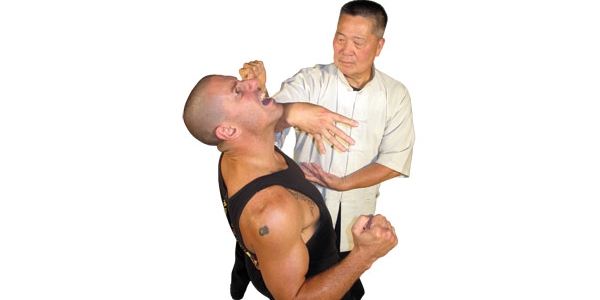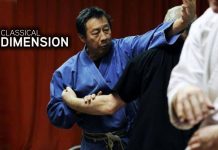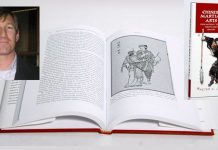
How do you know if your kung fu is real? Secret teachings, closed-door disciples, and special transmissions permeate kung fu legends. Feuding lineage branches frequently accuse each other of not receiving the true teachings. “Grandmaster never gave them the real stuff, only us!” or so the story goes. Do genuine masters really withhold their best David Chintechniques from their students? According to Grandmaster David Chin, they do. “The old traditional masters, they were so protective of themselves,” comments Chin. “They made sure they could make a living. They didn’t want the students to compete against them.”
In ancient times, a kung fu master’s art was his livelihood, so they were always vigilant against potential traitors. While few still earn all of their living from martial arts, the tradition of secrecy continues to create swirling controversies. In many traditions, keeping secrets is inherent, not just from students but also from the government. With our own national security now wrestling with the touchy issue of personal privacy, it’s worth examining how our martial forefathers hid the arts underground. These subversive masters were catalysts for evolution.
Grandmaster David Chin is an exponent of two major styles born from dissident teachings. His martial forefathers changed the identities of their arts, either to evade political oppression or as a protest against a totalitarian regime. Coincidentally, both styles also had deep connections to that very regime through the imperial guards, classic examples of one of kung fu’s time-honored thirty-six strategies: “Fool the Emperor to cross the sea.” Likewise, Grandmaster Chin crossed the Pacific to pioneer these anti-Imperialist arts in America.
Imperial Guards and Freedom Fighters
China’s final dynasty, the notorious Qing (1644-1911 CE), is cast as the villain in countless kung fu legends, movies and pulp fictions (wuxia xiaoshou). Consequently, few martial artists realize that this despotic dynasty began gloriously with three of China’s most brilliant emperors: Kangxi (1661-1722) Yongzheng (1723-1735) and Qianlong (1736-1795). The Qing was northern Manchurians, an ethnic group that never represented more than two percent of China’s population. And yet under those first three Qing emperors, Tibet and Mongolia fell under Qing sovereignty and China’s borders grew to the largest ever in her four-thousand-plus year history.
Such conquest has its price. To achieve this rapid expansion, government power was concentrated into a bloated tyrannical state that sucked the life blood from the people. Coupled with mounting population pressure, dwindling resources and the rapacious influence of foreign powers, successive generations paid dearly for Qing greed. For nearly two centuries, the Qing Empire collapsed in a humiliating downward spiral.
It was this adverse atmosphere that set the stage for a golden age of kung fu. The Qing Dynasty was the era of our greatest heroes. Almost every kung fu style traces its origins through champions from this period. Grandmaster Chin’s two main styles, Hop Gar and Guang Ping Tai Chi, were born of rebel heroes who lurked in the shadows of Qing tyranny and incited rebellion.
Hop Gar and the Ten Tigers of Canton
Hop Gar is the sibling of Lama Pai and Tibetan White Crane, all of which descended from a style known as Lion’s Roar. Lion’s Roar is a Buddhist term, most commonly used by Tibetan practitioners. The Buddha, like Jesus, was symbolized by a lion, so Buddha’s teachings are sometimes referred to as the Lion’s Roar. According to legend, Lion’s Roar was developed by a 15th century Tibetan monk named Ādatuo, who observed a fight between a crane and an ape. The crane’s ability to deflect the ape’s attacks inspired Hop Gar’s cloistered founder. In all likelihood, this creation legend is apocryphal, just like most tales of martial origins. The crane fight is uncomfortably parallel to another origin legend. In that one, a temple resident likewise observed a crane in battle, only in this case its opponent was a snake. Two very different styles emerged from these similar myths. In Tai Chi, the observer/founder was a Taoist shaman. In Wing Chun, the observer/founder was a Buddhist nun. Present research discounts both these stories. Regardless of dubious origins, Hop Gar is saturated with crane and Tibetan Buddhism symbolism and, like Tai Chi and Wing Chun, becomes historically valid during the Qing.
Tibet is the rooftop of the world. Although this sounds romantic, in truth, that soaring altitude is an extremely harsh environment that can barely sustain life. Tibetan people have to be incredibly tenacious just to survive in this barren landscape. This is reflected in Tibetan Buddhism, replete with horrific symbolism, of flayed skins, terrifying demons, flaming swords and grinning skulls. While westerners embrace the compassionate teachings of His Holiness the Dalai Lama, the complicated (and unpopular) back story is that, under Lama rule, Tibet was incredibly backward, with extreme poverty for the majority while the elite monk class enjoyed relative wealth. The monks were slave owners and by many accounts brutal warriors.
During that kung fu golden age, ten heroes with anti-Qing leanings rose up in what is now called Guangdong. Legends of the Ten Tigers of Canton have been retold in lineage tales, and in films, especially given that one member, Wong Kei Ying, was the father of China’s most celebrated cinematic character ever, Wong Fei Hung. The leader of the Ten Tigers was Wong Yen Lum, a vicious fighter who learned Lama Pai kung fu from a traveling Tibetan monk named Sing Long. Wong, a native of Guangdong, sought his fortune as a bodyguard escort. During his travels, he witnessed the oppression by the Qing and became a rebel sympathizer. It was because of this that Wong changed the name of his style from Lama Pai to Hop Gar.
Hop Gar (xia jia in Mandarin,家) means “knight/hero clan.” It is the same xia in mandarin as in wuxia, which is a term used to describe books and movies that exemplify martial heroes. “For generations, the Lama monks were imperial palace guards,” explains Chin. “There was much hatred for imperial loyalists. Therefore, Master Wong changed the name from Lama to Hop Gar to distance the art from the royal family.” Many Lion’s Roar enthusiasts add that Hop Gar is Wong’s interpretation of the art fused with other tactics gleaned from his extensive combat experience, as well as his legendary association with the other Ten Tigers.
One of Wong’s most popular tales is his return to Guangdong. In front of Hai Tung Monastery, Wong set up an elevated stage known as a leitai to accept challenges from any and all comers. Over the course of eighteen days, he defeated over one hundred and fifty challengers. “Either the challenger was maimed or killed,” noted Chin. “He never let one challenger leave his school without injury. He was a master of using the technique of cruelty.” There are four principles for Hop Gar: cruelty, evasion, penetration and interception. When asked about cruelty, Chin stoically quotes the Lama White Crane kung fu classics: “When hunting a tiger, destroy it. Otherwise, a wounded tiger will return to harm you. When weeding a garden, pull up the roots. Otherwise, the weeds will grow back. Whether the lion is hunting an elephant or a rabbit, the lion always uses full force.”
The Gold Mountain and Little Dragon
Like Wong, Chin is a Guangdong native, born in Sun Wei City in 1943. He began his study of Hop Gar at seven under his father, Chin Chong. The senior Chin was a student of Lee Jing, a direct disciple of Wong Yen Lum. At thirteen, his family immigrated to Stockton, California, but Chin never lost his interest in kung fu. He studied many styles under a throng of newly transplanted masters: Choy Lay Fut under his great-uncle Dean Loy (陳典來, a disciple of Chin Goong Bok, the son of Choy Lay Fut founder Chin Heung); Hung Ga under Mar Sik; Buddha’s Palm under Lee Keung; and Chin Yang Tai Chi under Lau Yee Sing. But he returned to Hop Gar, becoming an indoor disciple of Ng Yim Ming, better known as Harry Ng, when Ng arrived in San Francisco in 1970. While it might not have been as mythic a period as the late Qing Dynasty, it was part of another kung fu golden age, in San Francisco’s Chinatown.
In the late sixties, the nation looked at San Francisco for what was happening in the Haight Ashbury. Meanwhile, kung fu was becoming an American appetizer on the other side of the city, where Chinatown was bubbling over. Prior to his assassination in 1963, President Kennedy had worked towards a groundbreaking immigration act. Nicknamed the Kennedy Act by many Chinese, President Johnson signed the Hart-Celler Immigration Bill into law in 1965; it dismantled the old system limiting immigrants by their native country. This opened the floodgates for waves of immigrants to crash into the great American melting pot. Kung fu masters descended upon the Gum Shan, aka the Gold Mountain that was San Francisco. David Chin was right in the middle, living and studying in the city from ’62 to ’75.
Being in Chinatown at that time, Chin was an eyewitness to some of the most controversial challenge matches in American history, including one involving his own master Kuo Lien Ying (who challenged Chen Man Ching) and the most debated duel of all, Bruce Lee’s fight with Wong Jack Man. While Kuo vs. Chen isn’t relevant here (and might be a subject for a future article), Lee vs. Wong is irresistible because it was allegedly about keeping secrets. According to popular lore, Lee was challenged for teaching kung fu to non-Chinese.
Chin’s role in this fight was significant. “It ended up that I became the messenger boy and took the (challenge) note to Bruce Lee,” chuckles Chin wistfully. Of course, given the magnitude of Lee’s place in pop culture, only Wong’s students believe their master wasn’t defeated outright. Few beyond the martial arts community remember Wong, who only recently retired from teaching in the San Francisco area. So what really happened? “To me, you can say it went both ways,” recalls Chin. “Wong Jack Man was trapped by a window showcase. He fell and Bruce Lee got on top of him and that ended the fight. Wong Jack Man said he didn’t give up. He said he got trapped in that showcase. It was just an accident.” Furthermore, Bruce Lee wasn’t the first to teach non-Chinese. Non-Chinese students dot the lineages of plenty of other styles from the same period. “I don’t think it had anything to do with ‘don’t teach the gwailo (white ghost, a slang for Caucasians鬼佬).’ Stuff like that – it’s not true. Of course, Bruce Lee tried to make himself look good, but that wasn’t the case. It was strictly a match to see whose kung fu was better at that time.” So, the Lee vs. Wong fight wasn’t about keeping secrets. It was quite the opposite – a publicity stunt.
Guang Ping Tai Chi and the Stable Boy
Prior to Chin’s discipleship under Ng, he studied under another great pioneer of American kung fu, Grandmaster Kuo Lien Ying. Kuo arrived in San Francisco a few years after Chin. He was the bearer of Guang Ping Tai Chi, another style that emerged from Qing insurgents. Guang Ping was the product of Yang Ban Hou (1837-1892 CE楊班侯), the son of Yang Tai Chi founder Yang Lu Chan (1799-1872 CE楊露禪). By imperial Qing decree, Yang Ban Hou was commanded to serve as teacher for the royal court. No one could defy the emperor and live, so despite his anti-Qing sentiments, Yang cooperated; but he protested by covertly withholding the true kung fu from his Manchurian students. A stable boy named Wang Jiao Yu (王矯宇) spied on the private lessons and stole the teachings. Yang caught Wang, but realized that the boy was bonded to the Qing just as he was. In fact, they were both from the same place, Guang Ping City. So after testing his dedication, Yang took Wang on as a secret disciple, transmitting to him the true teachings. Many years later, when Wang was over one hundred, Kuo Lien Ying became his disciple. Wang allegedly died in a Taoist temple at age 121.
Chin was introduced to Kuo by his tai chi teacher, Lau Yee Sing. “When I watched him demonstrate, I had some doubts,” confesses Chin, “because his tai chi was not as big frame and graceful. It was not square or circular and a little hard. So Master Kuo asked me to root in a bow stance and put both arms in front of my chest. His hands touched my elbows lightly. Suddenly, he shook his body and I flipped into the air and fell ten feet away. I was very surprised and totally convinced. It was the first time I felt fajing (explosive power.” Chin studied the trinity of internal styles, tai chi, xingyi and bagua, under Kuo. “Master Kuo had me get up every morning at 5 AM to do zhuang zhong (standing post meditation站樁),” recounts Chin. “Guang Ping stance work is very boring looking, but if you want to know the true meaning of martial arts, start here. You get practical results from emptiness and stillness. Extreme yin is still external. Extreme yang is internal movement. Yin and yang continually move, never ending, never stopping. Today, people practice martial arts looking for the secrets and learning forms, but all the essence is inside your own body. Mind and spirit are the generals; bones and tendons are the soldiers. The Tao is not far. It’s the people who are far from the Tao. If you make a mistake in the beginning, it can put you a thousand miles off course. No matter what system, your stance must be steady. It must increase your power. Stance work is training your mind, body and qi, so the ancestors spent their whole lives studying stance.”
Let Me Tell You a Secret
Today, few Americans live the type of lifestyle conducive to achieving true kung fu mastery, so keeping secrets is no longer as important as in days gone by. Quite the opposite, most contemporary masters are revealing all their secrets, in fear that if they don’t, they may be the last of their breed. And no one wants their art to die with them. For Grandmaster David Chin, the secrets lie in the basics; unworthy students simply fail to keep up. “With Hop Gar and the original Yang tai chi, we pay a lot of attention into practice and training,” reveals Chin. “We train the technique like the alphabet. It’s not how many forms you do; it’s how much theory and philosophy you can digest. So we can use the 24 hands and come out with lots of power, movements and applications. We put people into sparring and let them feel the movement, explore themselves, use it freely.
“To come to that stage isn’t easy. Many people come to the first six months, they quit already. Iron palm training to mook jong, blocking, it’s not easy. They can only go so far and they just lost interest. For example, we have six different short forms; the techniques of those forms are applications for fighting. They train student to fight. This form alone, they learn for a year. Other people say, ‘Look, I can learn this in a few days.’ But to try to perfect it, to make it become part of you – you are the Hop Gar, the Hop Gar is you – that’s not easy. It’s like it all depends which mask I put on – the Hop Gar David Chin or the tai chi David Chin or the xingyi David Chin. The mask is still David Chin. Too many people rely on technique and secret movements to bail them out. It ends up the secret movement is never there. You have to become natural and react to the situation.”
Unfortunately, modern day martial arts have also lost the check and balance of challenge matches. Unlike the traitorous students of days gone by, today’s thief seldom faces the wrath of a true kung fu master on a leitai. “It’s worse today,” continues Chin. “In fact, I run into it occasionally. So many students come and learn for six months, then they claim they learned from me. I will not allow that. I only certify certain people. They don’t have the aspect of wude (martial ethics武德). No respect. A student learns halfway somewhere and then they start changing. They make their own style. That’s why we end up with so many new styles.
“Are they really making anything that much different compared to other old styles? Maybe not. Kung fu, after all, is just two hands, two feet and the body. That’s it. Different styles specialize on different techniques and usually these people don’t pick them up. They don’t know how to use them. For example, tongbei is different than regular kung fu. It’s the way they use the power, the way they deliver momentum and striking force. That’s what makes it outstanding. I don’t say that these new styles are bad kung fu or anything like that. I always say ‘Whatever you do, I don’t want. Whatever I do and you don’t know – that’s how we win.'”
Grandmaster David Chin can be contacted through his school, David Chin’s Kung Fu Center, 2444 Dunn Rd, Fayetteville, NC 28312-8874, 910-485-0039. Visit his website
Written by Gene Ching for KUNGFUMAGAZINE.COM © COPYRIGHT KUNGFUMAGAZINE.COM, ALL RIGHTS RESERVED.
All other uses contact us at gene@kungfumagazine.com.








